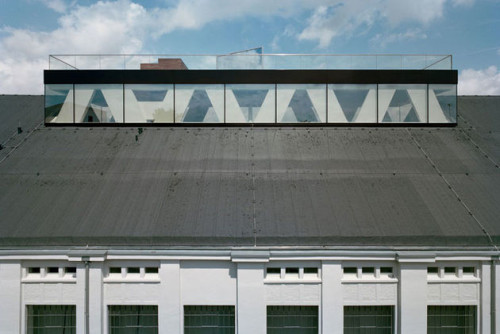
The Julia Stoschek collection, initiated in 2004, is entirely dedicated to new media art and offers a rather original choice that can be easily recognized as an interest in the art of our time, tied in conception and fruition to the liquid world of the so-called new media, from photography to net art, by way of videos and interactive installations. The collection is not very well-known in Italy but it has been the subject of various exhibits in Germany and in the rest of Europe. The exhibition policy is the other facet of an ambitious programme dedicated to the preservation of delicate works of art that risk rapid obsolescence due to continuous technological updating.
The collection Headquarters is located in a former industrial building that has been brilliantly remodeled by the Kuehn Malvezzi studio, with spacious exhibit areas and sophisticated systems for the archiving as well as the physical and digital preservation of time-based works.

The combination of a dynamic exhibition policy and a well-structured preservation project makes this private collection quite unique in Europe and oriented towards the objectives of a public institution in many ways. It comes as no surprise that this initiative came into being in Germany, where the ZKM is an international reference point for new media art notwithstanding the fact that other museums have also oriented their purchases from time to time towards the same expressive genre. The same can be said of Italy, where videotapes and video installations are integral parts of public and private collections dedicated to contemporary art with all the specific issues new media art presents regarding visibility and preservation.
Another point of interest would be to assess the type of response that the Julia Stoschek Collection provides to this kind of challenge, considering that the young collector is personally responsible for many curatorial choices.

The line of purchase moves freely in a variety of directions from historical material of the 1970s (Gordon Matta-Clark, Nam June Paik, Robert Smithson) to younger artists (Cyprien Galliard, Klara Lidén, Clemens Von Wedemeyer or Tobias Zielony, to name a few) including substantial documentation of actions and works that are authentic short films, photographic series and sound art, works of Second Life and interactive installations according to itineraries – doubtlessly individual – which also reflect the complexity of an expressive genre that has become very well-structured and extremely representative of contemporary art. Among the artists present, the roster includes such prestigious names as Marina Abramovic and Bill Viola, Bruce Nauman and Adrian Piper, Sophie Calle and Isaac Julien, Adrian Paci and Cao Fei, Robert Pruitt and Trisha Baga et cetera. The only Italian artist featured for the time being is Monica Bonvinci but, with the help of some dynamic private galleries, we can hope for more coverage and perhaps even a presentation of the German collection here in Italy.
The exhibit policy used for the Julia Stoschek Collection is articulated by theme-related shows dedicated to illustrating particular aspects of our time –urban entropy, topic of the recent exhibition in Budapest, or the cult of the exaggerated and artificial typical of the Dandy aesthetic movement – using the collection to propose different types of itineraries or (less frequently) solo shows like the one dedicated to Sturtevant which will be opening soon in Düsseldorf.

Visiting this kind of exhibition also offers spectators an opportunity to grasp the historical depth that new media art has accumulated over time since the 1960s and how its relationship with more established fine arts has changed. In fact, for more than a decade comparison with cinema, painting and design has become a regular item on the arts agenda alongside an observation of today’s world with its social and environmental emergencies, its contradictions and transformations – from China to South America.
images
(1 cover) Installation view. Olafur Eliasson, When Love Is Not Enough Wall, 2007, JULIA STOSCHEK COLLECTION, Duesseldorf. Photo: Achim Kukulies, Düsseldorf (2) View of the new attic floor of the JULIA STOSCHEK COLLECTION, Duesseldorf. Photo: © Ulrich Schwarz, Berlin (3) Photograph of the building of the JULIA STOSCHEK COLLECTION, Duesseldorf, circa 1911/12 (4) Installation view of the exhibition NUMBER ONE: DESTROY, SHE SAID, JULIA STOSCHEK COLLECTION, Duesseldorf. View of the first and second exhibition floor. Photo: © Ulrich Schwarz, Berlin (5) Installation view of the exhibition I WANT TO SEE HOW YOU SEE – JULIA STOSCHEK COLLECTION, 2010, Deichtorhallen, Hamburg. Photo: Hennig Rogge, Hamburg.







































